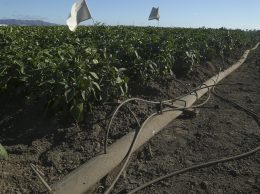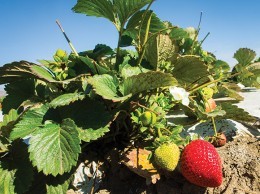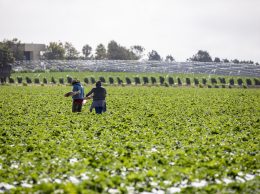Funding farming’s future: USDA tags Tri-Counties for program
IN THIS ARTICLE
- Agribusiness Topic
- Marissa Wenzke Author
By Marissa Wenzke Friday, August 8th, 2014

The value of the strawberry crop in Ventura and Santa Barbara counties dropped 5 percent to just over $1 billion last year as farmers struggled with the drought. (USDA photo)
A $10 billion federal fund from the U.S. Department of Agriculture could provide much-needed assistance for developing water systems and other infrastructure in the Tri-Counties, where the region’s agriculture industry has suffered tremendous losses from the drought.
The USDA has designated Ventura, Santa Barbara and San Luis Obispo counties as “drought disaster counties” as the effects of a three-year drought deepen.
Perhaps most noticeably, Ventura County reported that strawberries, its longtime top crop, saw a 12 percent drop in value last year as a result of the record-breaking drought, and cattle farmers in Santa Barbara and San Luis Obispo counties have been thinning their herds.
Through the $10 billion nationwide initiative, called the Rural Infrastructure Opportunity Fund, the USDA is inviting private entities to invest in developing rural infrastructure, such schools, roads and water systems, across the U.S.
“The fund will allow a wide variety of new participants, including pension funds, endowments, foundations, and other institutional investors that have not traditionally had access to these markets to invest in rural development,” the USDA said in a statement.
“It’s the infusion of capital into rural America from outside investors who don’t typically invest in rural America,” said Dan Sullivan, spokesman for CoBank, the lender that’s providing the initial $10 billion for the fund and helping the USDA to review applications of projects that are seeking funding. The pool of private money will also sometimes be leveraged with additional government grant money.
For the Tri-Counties, the new fund could mean money for desalination projects, recycled water projects and other infrastructure that would addresses issues of depleted groundwater, saltwater intrusion and a lack of new water sources, according to Mike Solomon, general manager at the United Water Conservation District.
Seeking new water sources
With a worsening drought that has been going on for at least three years, Solomon said, the Tri-Counties must either find new sources of water or face mandatory reductions in water usage if it doesn’t rain sufficiently this winter.
“We’re at a dangerous point,” Solomon said. “We’ll be in a critical position if it doesn’t rain next year.”
While farmers have been told to cut back on water use, some crops such as strawberries continue to “need more water than this area can afford right now,” he said. He said the crop is being grown at “an unsustainable rate, based on what we currently have available.”
Strawberries are the top crop in the region, with its combined value in Santa Barbara and Ventura counties clocking in at just over $1 billion, about 5 percent lower than in 2012.
If sources of new water are not found, Solomon said, it may be necessary for governments to limit the number of water-intensive crops that can be grown in the region. Reliance on groundwater cannot continue, based on the extremely low levels already being seen, he said. Instead, Southern California should look to import more water from Northern California through the State Water Project, he said. “There are only so many low-flow toilets and showerheads,” he said. “The conservation will give us a little reprieve, but it’s not the answer.”
Slow-growth limits
Steven Slezak, a professor in agribusiness and financial planning at Cal Poly San Luis Obispo, said more irrigation infrastructure and other development in San Luis Obispo faces a wall of “anti-development politics” in the region.
“One of the problems in this area is the idea that we always have to limit growth,” he said. “I imagine a lot could be done, but it would have to be under the right circumstances. … The willingness of the local community to grow puts
a limit on how much these investors can do.”
Compliance with rural use and planning laws is a major obstacle for future development, according to Slezak, who said the drought has already hurt cattle populations. He said ranching has taken an especially hard hit, as shown by smaller herds and spikes in value caused by ranchers selling off large amounts of cattle due to a lack of feed.
Selling off cattle
Both Santa Barbara and San Luis Obispo counties experienced a surge in the dollar value of their cattle in 2013, but experts say the increase is actually a symptom of peril — ranchers are rushing to thin their herds because there isn’t enough grass to feed the animals. In Santa Barbara County, the value of cattle ranching rose from $31.7 million in 2012 to $32.4 million last year. In San Luis Obispo County, the increase was from $69.4 million to $96.4 million.
“Significant drought conditions put pressure on the cattle industry to reduce herd sizes as natural forage was low and supplemental feed costs were high,” the San Luis Obispo County Agricultural Commissioner’s office said in its annual report. It could take several years after the drought for the county’s cattle industry to return to normal, the agency said.
Stressed-out farmers
Wine grapes, another of the Central Coast’s top crops, are also suffering as a result of the scarce water. “Water’s just not available to them and they can’t get permits to deepen their wells,” Slezak said of wells in the Paso Robles area.
According to Robert Saperstein, a Santa Barbara attorney who practices water and environmental law, a decade of increasingly tough and complex federal and state regulations, including the Endangered Species Act, have compounded the effects of the worst drought in California history. “It’s been over 10 years of regulatory obstacles,” he said. “That has made this particular drought far more devastating than any one before.”
Farmers are stressed, Saperstein said. “The general level of anxiety has never been this high, in my career, over water supply,” he said.












